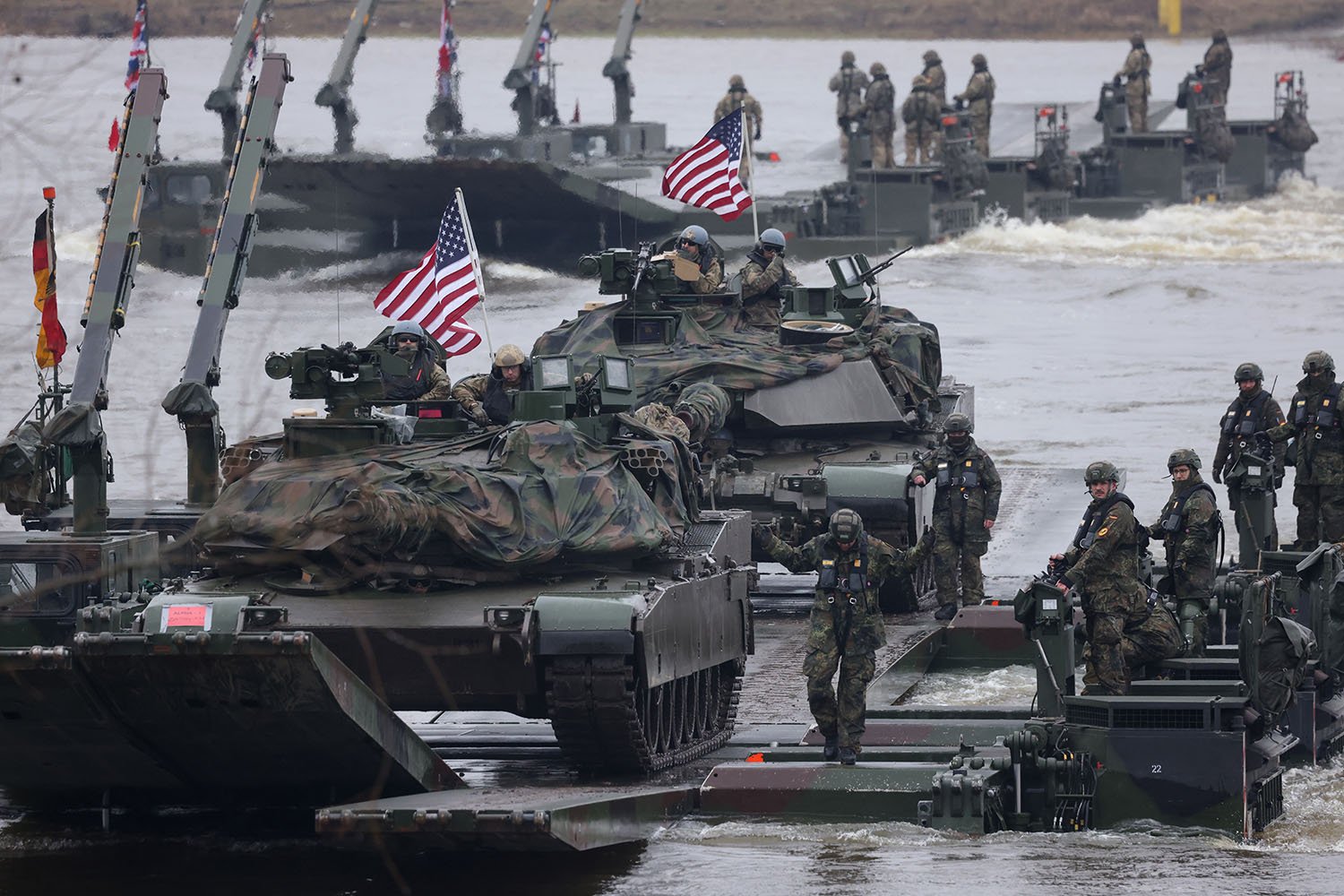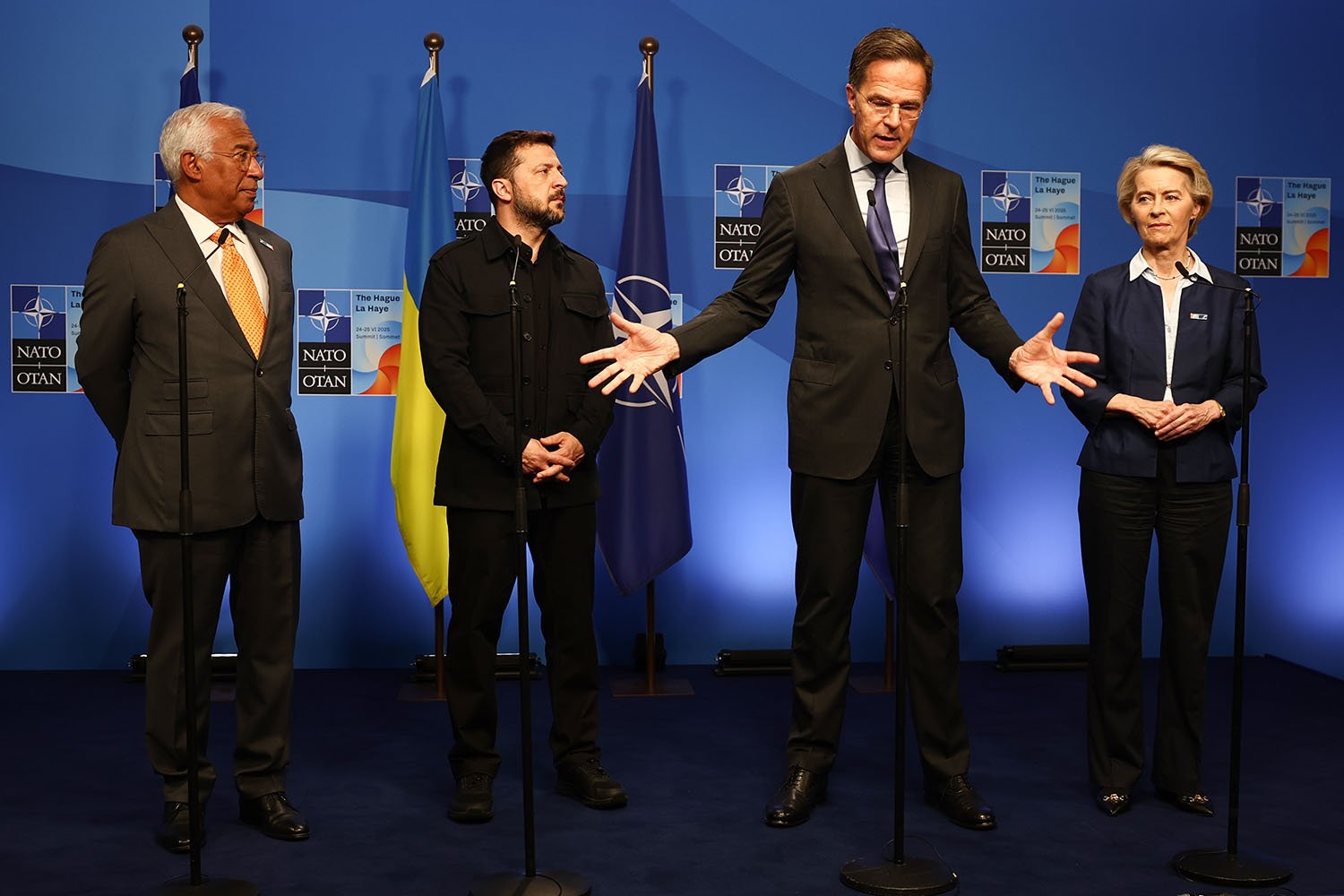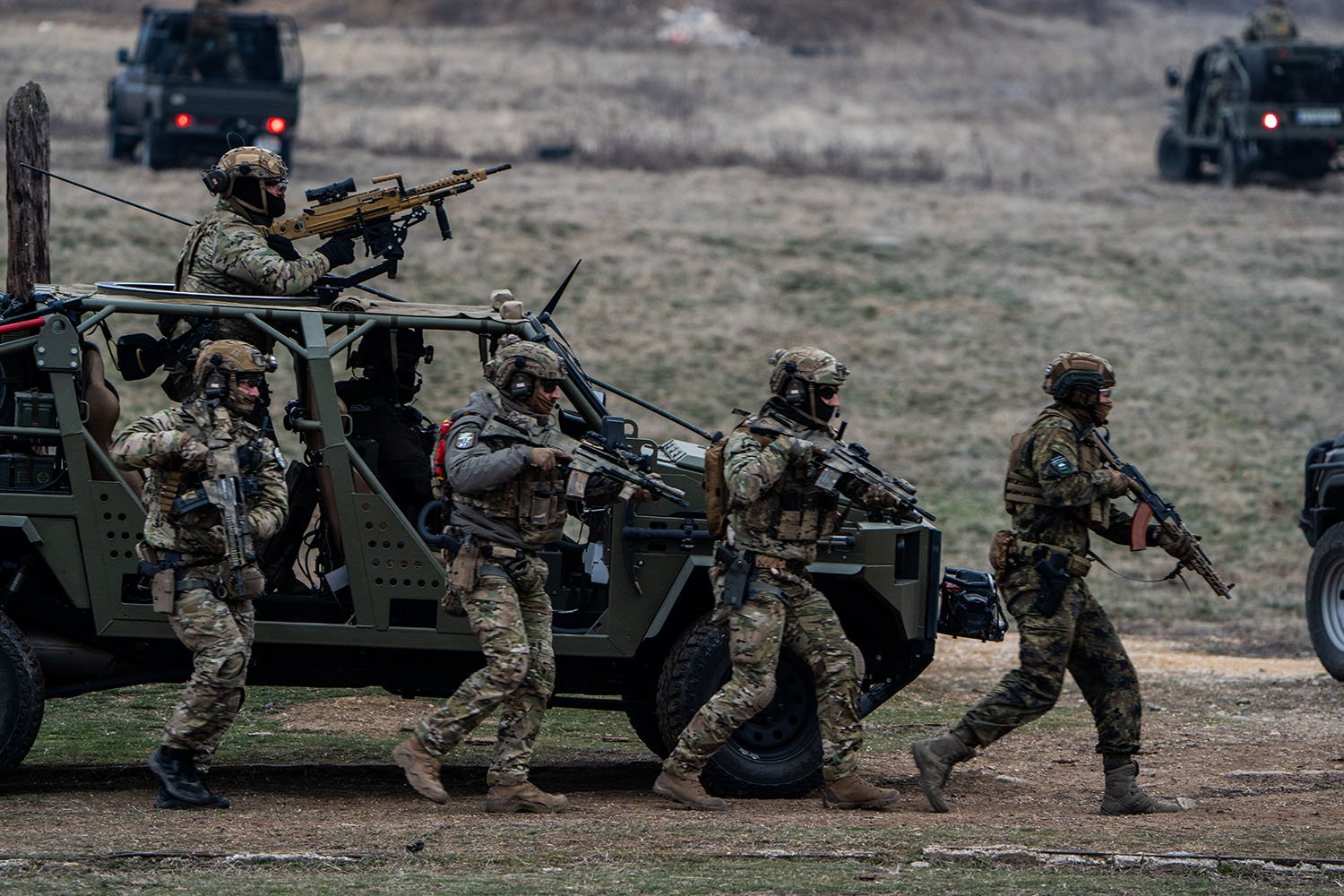Ten years from now, the United States should have no significant troop presence in Europe.
Realists are in broad agreement that the United States is overcommitted there. Indeed, the fact that the U.S. military remained in Europe after the end of the Cold War seems profoundly at odds with realism’s assumption that alliances are primarily a response to threat. But whether bureaucratic politics or simple path dependence are to blame, the fact is that, 30 years after the collapse of the Soviet Union, the United States is still largely responsible for protecting Europe. And the geographic scope of the commitment has expanded to encompass all of the former Warsaw Pact countries.

As a result, NATO’s membership has doubled. The United States currently has around 100,000 troops stationed in Europe. Troop levels increased after the start of the war in Ukraine in 2022, but even in more normal times, the U.S. troop commitment to the continent has hovered between 50,000 and 75,000. Existing base structures—and the slowly dying Treaty on Conventional Armed Forces in Europe—keep the majority of U.S. personnel based in Germany, Italy, and the United Kingdom, but growing numbers are now stationed in Eastern European states on a rotational (but, in practice, permanent) basis.
Perhaps more important than the raw number of troops is United States’ role as a technological and logistical enabler for European forces, which often lack key capabilities in intelligence, surveillance, and reconnaissance (ISR); airlifting; or refueling. The Libya intervention in 2011 is perhaps the clearest example of U.S. centrality to European force projection; though initially intended to play the primary role in the intervention, European forces were not able to sustain operations alone. The United States ended up providing ammunition, air-to-air refueling, and significant intelligence support. As one observer at the time put it, “Europe flew the planes and attack helicopters, but most of the time they were firing U.S. munitions at targets identified by the U.S., in operations coordinated by U.S. technology.”
There may be specific niche capabilities—particularly in the intelligence space—that the United States continues to provide in Europe. Most existing capability gaps, however, should be filled by European nations, whose forces must be capable of responding to crises without immediate U.S. assistance. In particular, European forces should be sufficient and appropriately postured to deter Russia, which remains the most obvious external security threat.
Shifts in U.S. troop presence in Europe should be matched by shifts in rhetorical and practical commitments to European states’ security. The United States does not need to formally withdraw from NATO unless no other choice presents itself. But in pulling back, the United States should make clear that it intends to fulfill the role of a guarantor of last resort—providing arms and assistance rather than direct military support—in almost all cases. The United States should maintain its nuclear guarantees to Europe for several years until an acceptable European substitute emerges, but it should also exert strong pressure to encourage either the European Union to develop a joint nuclear deterrent or France and Britain to extend guarantees to their neighbors. It is possible that this move could prompt Polish or German proliferation if British or French extended deterrence is perceived to be non-credible. But that remains highly unlikely; after all, why would a suitable British nuclear commitment be less credible than a U.S. one? Ultimately, the risk of a limited amount of proliferation in the European context is not a significant threat to U.S. interests.
There is no inherent contradiction between the United States’ Article V commitment to NATO and a declaration that the United States intends to avoid the direct use of force in the region. Article V only commits states to take whatever action they deem necessary to support an attacked state; as the case of Ukraine highlights, a more hands-off approach that prioritizes arms, intelligence, and economic assistance can be highly effective in bolstering the abilities of partner states to defend themselves. A U.S. role as a final guarantor of European security—a balancer of last resort, willing to intervene only when Europe as a continent truly faces an existential threat—remains consistent with NATO membership. In 15 years, in an ideal world, the United States and Europe should be relatively equal partners and allies, not security provider and dependent.
-

Tanks with U.S. flags on them float on rigs in a river while soldiers accompany them.
Any process for the European Union to build comprehensive defense will likely take decades. It may well look like the lengthy and messy processes of political compromise that eventually resulted in the Common Market and the euro. NATO, on the other hand, is substantially better positioned to defend Europe in a crisis—thanks to existing command structures—but remains heavily dependent on U.S. capabilities. Any viable path forward for European defense will need to include both an evolving role for the EU and a gradual shifting of responsibility inside the existing structures of NATO.
The result of these myriad problems has been policy paralysis. European states remain bogged down in overarching debates about the form a common European defense would take—the recent release of the European Union’s first Strategic Compass is one such example—and have failed to make real-world progress. Since the start of the war in Ukraine, analysts from the London-based International Institute for Strategic Studies (IISS) have noted that “no major recapitalization of armed forces or large- scale procurement to address capability gaps have yet materialized.”
Paradoxically, although Russia’s stunning losses in Ukraine mean that there has rarely been a safer window for the transition of European security from U.S. to European hands, it has remained easier to pass the buck to the United States than to overcome tough collective-action problems. As Sean Monaghan, an official in the British Ministry of Defence, describes it, European states face “entrenched bureaucratic challenges to cooperation.” Any coherent attempt to implement this transition will require strong action from policymakers to overcome policy inertia.
The timing of transition from U.S. to European defense responsibilities is perhaps the most critical question. A recent scholarly debate on the prospects for European defense put this problem into stark relief. A study from the IISS explored several scenarios, each of which assumed that the withdrawal of U.S. forces from Europe was sudden and would be followed by an almost immediate Russian intervention, and concluded that European states could not defend themselves. The scholar Barry Posen, however, called that calculus into question in his response, noting that it changes substantially if European states are given time to adapt to the U.S. withdrawal. These debates suggest a long lead time for the transition, during which the United States gradually shifts the burden across various defense competencies to European states, rather than any sort of sudden shock. Of course, U.S. leaders have been intimating a shift away from Europe for years now, most notably during the Obama administration’s attempt to pivot to Asia. It has done little thus far to bolster a European resolve to act.
For this reason, it is important for U.S. policymakers to be as clear as possible on the withdrawal process and timeline. Adding a set of concrete deadlines that are close enough to concentrate the mind, but far enough out to achieve real change, can help. Ten years is a plausible and eminently achievable target; even the IISS report—with its relatively pessimistic assumptions—argues that a sufficient recapitalization program across Europe could yield results in eight to 12 years for land-based forces, a decade for air capabilities, and 15 to 20 years for maritime capabilities. Land forces and certain air assets are the most important components of a credible European defense, particularly given that—in contrast to the IISS report’s assumptions—the United States is highly likely to continue its general role as guarantor of the global maritime commons. Ten years, however, is a long time, and there will undoubtedly be questions about the credibility of U.S. willingness to step back from Europe. This problem could not have been more clearly illustrated than by the U.S. withdrawal from Afghanistan in 2021: Many European states found them- selves shocked that the Biden administration followed through on its promise to pull out of Afghanistan. The U.S. commitment to dialing down its European commitments must thus be credible enough that it is taken seriously by European states; it cannot simply be a verbal rehashing of decades of burden-sharing debates.
For this reason, U.S. policymakers should commit to both a long-term drawdown of forces in Europe and a clear plan for how that withdrawal will be phased over time. The United States should withdraw the most easily replaced capabilities first and plan for a longer horizon on more complex capabilities. This would suggest the earlier withdrawal of U.S. infantry brigade combat teams (BCTs) and of logistics and sustainment for these forces; this should be accompanied by a transition to a European strategic allied commander. In the medium term, the United States should target the withdrawal of harder-to-replace armored BCTs, along with artillery as well as refueling and airlift capabilities. The capabilities that are the most challenging to replace—including missile and air defense and warning systems—would be among the last to depart; certain niche capabilities in the ISR space, along with strategic nuclear assets such as the Aegis Ashore ballistic missile defense system, may persist until or even past the 15-year mark. Pre-positioned matériel for U.S. forces can be repatriated or can be sustained if U.S. policymakers wish to maintain maximum flexibility going forward.
This timetable should be made more credible by shifts in Pentagon spending and in the programs appropriated by Congress; defense budget documents should clearly specify what is being cut and when programs will become surplus to requirements. Perhaps most importantly, although there is room for give-and-take during this process, the United States should in general follow through with the withdrawal of appropriate capabilities regardless of whether European states step up by specified deadlines, which will increase the credibility of the overall process. At the end of this process, the United States should have relinquished almost all control over European defense, removed its ground and air forces from the continent, and returned to a largely offshore posture.
The next question is strategic. Both Europe and the United States have in recent years focused on European-level solutions to the problem of defense. Europe, in the aggregate, “has the security demands and interests of a great power,” as scholars from the Center for Strategic and International Studies (CSIS) recently noted. But it is not a unified political entity. Top-down change in European defense has thus far proved disappointing at best. Instead, the United States should focus on encouraging bottom-up strategies for European defense, helping Europe’s constituent states build a backstop of national defense capabilities and the structures that allow like-minded states at the sub-European level to pool those resources effectively. This is the only viable way to avoid a lowest-common-denominator approach to defense that fails to provide sufficient security for member states. This may sound counterintuitive—and for Europeans who are supportive of “ever closer union,” it may be close to sacrilege. But much as the transition to the Common Market, or the transition to the euro, required European states to first reach specific levels of interconnectedness, economic development, and fiscal goals, a transition to a common security and defense policy that links European states can be based only on a foundation of strong national defense capabilities. Indeed, to the extent that the European Commission has built a more robust diplomatic presence in recent years, it has followed this path, building on—and co-opting—the strong diplomatic corps of its member states.
The most common criticisms of building up defense at the national level are twofold: first, that it is infeasible for Europe’s smaller states to manage without French or German help, and second, that it will inevitably result in duplication and waste. But both concerns are surmountable. France, Germany, and the United Kingdom are Europe’s behemoths, capable of mounting a comprehensive defense on their own. But groups of small and medium-sized states that share common threat perceptions and common interests can also be effective in pooling their resources to produce comprehensive defense capabilities. Poland, the Baltic states, and their Scandinavian neighbors form a natural grouping concerned about deterrence against Russia and about spillover of the war in Ukraine. The countries of the Black Sea region—Romania, Hungary, and others—already cooperate on maritime issues and have already engaged in cooperative work on energy and transit infrastructure through the Three Seas Initiative. Italy, Spain, Greece, Cyprus, and Malta form a natural axis concerned with migration, instability in the Middle East and North Africa, and the security of the Mediterranean Sea. And Britain, Germany, and the Scandinavian states share interests in Baltic and even Arctic security.
The idea of sub-NATO (or sub-EU) groupings based on geography and interests—which themselves tend to be strongly correlated—is not an innovation; during the Cold War, NATO used a geography-based command system. By building groupings around common threat perceptions and retaining capabilities locally—or at least sub-regionally—countries can mitigate some of the worst concerns associated with trying to solve the common-defense collective-action problem in Europe. Because the states involved share common threat perceptions, it is less difficult to win consent and to prioritize, and because capabilities can be pooled across countries, smaller countries are still able to benefit from economies of scale. It can also help mitigate the presence of unaligned states like Hungary and Turkey inside existing alliance structures by relegating them to a minor role and removing their veto capabilities.
That said, there is also a strong role for both the European Union and NATO to play in coordinating and nurturing this process. NATO’s standing bureaucracy is well equipped to help identify areas of common threat and strategic opportunity, to deconflict procurement between member states, and to avoid overlap or gaps in capabilities. The EU, meanwhile, is well placed to encourage the creation and sustainment of a European defense-industrial base and to fund it through Eurobonds or other monetary innovations. As the authors of one recent report advocate, a process not unlike that which produced the common agricultural policy would be helpful in protecting national interests in the defense space while advancing broader European interests. The common agricultural policy may be no one’s idea of a best-practice approach to governance, but when it comes to mitigating the worst impulses of nationalism to achieve broader comity on critical questions, it has been surprisingly effective.

The United States cannot ultimately be directly responsible for the choices European states make during this process. But the United States will be crucial to planning on the NATO side of this equation. U.S. policymakers can help encourage the formation of these blocs in several ways, especially through diplomatic engagement that seeks to identify appropriate partners and bring them together within the confines of the U.S. drawdown process. Perhaps more controversially, U.S. policymakers must also be willing to get out of the way of the European Union on defense procurement issues, particularly in avoiding any insistence on a preference for U.S. arms suppliers over European suppliers during this process.
Ideally, the process of building sub-NATO constellations for defense—and the involvement of both NATO and the European Union—would eventually lead to greater pan-European integration and contribute over time to a more coherent EU defense and security policy headquartered in Brussels. There is a clear public demand for this: 77 percent of respondents across Europe were in favor in one recent poll. But even if this process does not result in broader supranational defense capabilities, it should still be capable of achieving homegrown European defense and deterrence at an acceptable cost—and without significant U.S. commitments. Throughout this process, policymakers should remember that U.S. interests are best served by an effective defense of Europe; these interests do not require it to happen through any specific institutional forum. Building a common European defense may, as one author put it, be a “generational project,” but the phased transition to European defense of Europe does not have to be.
The post Passing the Baton in Europe appeared first on Foreign Policy.





